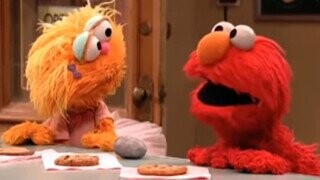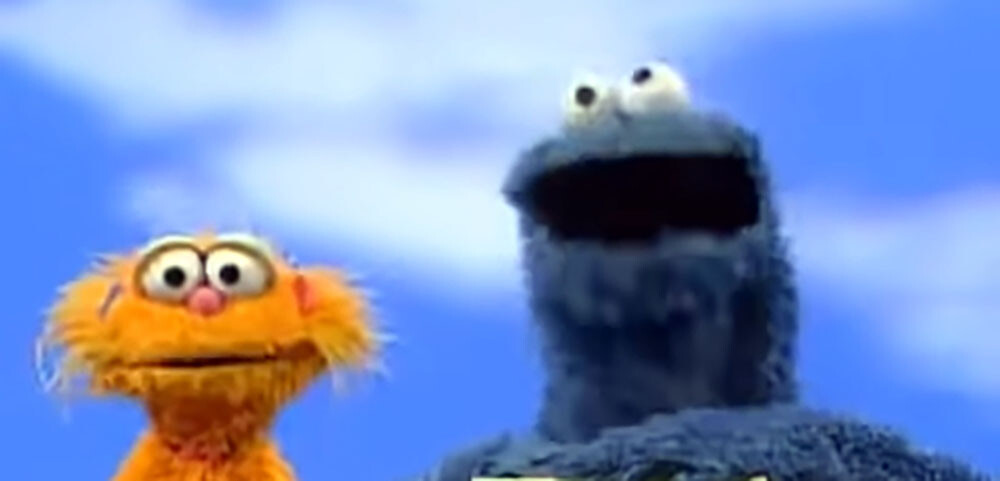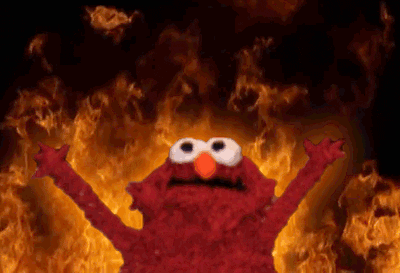Four Scenes That Could Never Air On Sesame Street

Welcome to ComedyNerd, Cracked's daily comedy superstore. For more ComedyNerd content, and Elmo's take on the Iran/Contra Affair, please sign up for the ComedyNerd newsletter below.
I don’t know if the Sesame Street characters have just been getting restless with all this sitting inside the last couple of years, but it seems like they’ve been coming up a lot recently.
Don't Miss
Now, if you’re a preschooler and you’re reading this — first of all, incredibly advanced reading skills, well done, and congratulations. But second of all, you’re probably asking, “Recently? What do you mean? My fellow three-year-old friends and I are constantly talking about the trials and tribulations of our dear pals on Sesame Street!”
Well, you little toddler genius, allow me to briefly explain. Remember when everyone was freaking out that Big Bird had a bunch of cousins? And how about when Ted Cruz thought he was a propaganda figure for the COVID vaccine? Big Bird has had quite the year.
And of course, a few new Muppets who are Asian American and Black have joined the cast to help educate on anti-racist issues.
But in all of this, there has perhaps been no greater headline-maker than Elmo’s tirade against a pet rock. If you haven’t seen it, it’s worth the watch.
The clip is from 2004, but it resurfaced and is resonating now — presumably for many reasons. One of which might be that someone finally said no to listening to that punk rock (Get it? It’s a genre but in this instance, it’s also an insulting nickname- never mind).
Moreover, it’s kind of refreshing to see Elmo, a character known for cuteness and compassion, being uncharacteristically angry. However, as someone who’s written for Sesame Street projects for the better part of the last two years, I can say with confidence that if anger wasn’t within Elmo’s character, it would never have gone to air.
Sesame Street does not mess around when it comes to writing. While Elmo yelling at Rocco may seem out of character, I’ll go through some situations that, according to the Sesame rules I picked up, would actually get a big red X — and I’m not just talking about the letter of the day.
First, Could You Tell Me How You Got… How You Got To Sesame Street?
How do I know so much about the Street?
A few years ago, I started as a Media Production intern at Sesame Workshop in the International Social Impact department. Each of the department's co-productions has a humanitarian bent, equipped with custom, regionally-specific characters. For instance, in the South African Takalani Sesame, the main Muppet girl Kami is HIV positive, in an effort to destigmatize HIV and AIDS in the region. In Afghanistan, the main Muppet girl Zari loves to read, promoting girls’ literacy in the nation. In the U.S., Elmo hates rocks.
In 2019, Sesame Workshop received a $100 million grant from the MacArthur Foundation to create Ahlan Simsim, a show for audiences in the Middle East and North Africa, targeted specifically at displaced children (read: refugees) affected by the Syrian civil war. There’s a lot to talk about with this program, but that’s probably for another article.
Long story short, I began work on this show in early 2020. For most of the two years since, I helped write and oversee the creation of every episode, segment, and animation script the show produced. This is all to say, I’ve gotten to know these characters very well. And, accordingly, my understanding of how to write for them is pretty indelible. Some might even say… rock-solid (sorry Elmo, had to).
So without further ado, let’s get into these theoretical Sesame Street rule-breaking scenarios.
Rule-Breaking Scenario 1: Wordplay by the Rules

Sesame Street
Cookie Monster and Zoe are walking along the sidewalk together, enjoying some delicious, fresh-baked cookies. Suddenly, Cookie Monster trips and accidentally flings his cookie through the air — right at a parked car! The cookie falls to the ground and Cookie Monster picks it up and throws it out, but Zoe notices something amiss with the car.
“Oh no,” she says. “Your cookie! When it knocked into the car, it chipped the paint!”
Cookie Monster looks at her.
“No, Zoe…” he says. “It chocolate chipped the paint.”
The Broken Rule
Okay, two friends enjoying cookies, having an accident, making a cookie joke… seems passable, right?
Here’s where the audience comes into play. The target age of Sesame Street is really preschoolers and younger. It’s very early education, for very early learners.
That means a wordplay joke like “chocolate chipped the paint” will likely fly over all of their heads… except for maybe the amazingly smart three-year-old reading this article right now. But that’s an exception.
When writing for a Sesame Street program, any wordplay at all is avoided in the scripts. These jokes just will not land with the intended audience.
At the same time, humor is tremendously important to Sesame Street. To help convey educational content, humor is one of the secret ingredients to keep the young audience engaged and allow them to actually retain the content.
Since wordplay is off the table, we’d resort to other kinds of comedy. There’s physical comedy, like a character trying really hard to pull something that’s stuck — then finally getting it free and being knocked over. There’s also general silliness, like Grover wearing a really outlandish hat, or screaming willy-nilly about something random. At times, there’s character-based comedy, like everyone knowing Cookie Monster is going to go crazy for a cookie, or Grover saying “everything is going according to plan!” when things are clearly not going at all according to plan.
Sometimes comedy for adults is slipped into kids’ media, a la the jokes in Spongebob. That's deliberate and there’s actually a name for it: “cross-writing.” That technique used to be really relevant when families only had one television set, and shows had to keep parents as entertained as their kids or else they’d change the channel.
Now with streaming and the ability to watch on all kinds of devices, cross-writing has faded in relevance. Especially for a show like Sesame Street, these jokes aren’t used much at all. If they were, you probably would have heard Elmo telling Rocco he belongs in the ground. Kids would have understood: right, rocks belong on the ground! Adults would have understood: oh, Elmo wants to legitimately murder this rock.
Rule-Breaking Scenario 2: Paint a Picture, Carefully

Sesame Street
Grover and Elmo decide it’s a great day for arts and crafts! They break out fresh canvases and new paints. But instead of brushes, they decide to use a different technique: finger-painting!
The two friends have an amazing day finger-painting together, laughing about their messy hands. They share their paintings: Grover painted a cute picture of a whale! while Elmo painted a rock burning eternally in the fiery abyss of hell.
The Broken Rule
OK, yes, Elmo’s hellscape painting breaks a lot of rules. Let’s ignore that.
The broken rule that may not be so obvious is the choice of activity: finger-painting. On the surface, this is a cute, fun art project for kids. But these aren’t just any kids on Sesame Street. They’re Muppets.
Muppets are practically celebrities. They’re ultra-valuable to the production, and they’re only made in one place: Jim Henson’s Creature Shop, aka the Henson Workshop. People at Sesame Street truly value these characters like they would a human life. (I know this firsthand because I once had to transport Cookie Monster on the subway from Manhattan to Queens, and they basically said whatever happens to me, don’t let anything happen to that monster.)
So it’s imperative that we treat these Muppets right. That means we cannot, under any circumstance, get them messy. Paint on Muppet fur would be a huge no-go.
On set, in addition to the puppeteers, there’s a team of wranglers who are responsible for the care of the Muppets. A big part of this responsibility is keeping them clean and pristine — and finger paints would pose way too big a risk for stars like Elmo and Grover. Can’t be seen with dirty hands, since you never know when the paparazzi Muppets are watching…
In this vein, another huge Sesame Street rule is you can’t take photographs of any limp Muppets. For example, sometimes a stray Cookie Monster will be resting face down on a table. This is prohibited to photograph. Unless there’s a puppeteer playing them — or in certain instances, if they’re posed on a wire — Muppets cannot be photographed. This is to maintain the illusion for children that they’re really alive.
To Elmo, on the other hand, the illusion Zoe maintains that Rocco is alive is a blasphemous farce that needs to end or he will end it for them.
Rule-Breaking Scenario 3: Where There’s Fire, There’s Fire
Elmo has decided he has had enough of the childish games.
In the dead of night, he retrieves Rocco from Zoe’s quarters. He stuffs Rocco in a thick wool sock, knowing full well it would hurt Zoe to imagine Rocco suffocating. Elmo doesn’t care. In fact, Elmo enjoys it. He wants Rocco gone.
Elmo brings Rocco back behind a brownstone into a secluded narrow alleyway. They are completely alone. Elmo’s depraved face contorts with sadistic pleasure.
He soaks the sock in kerosene, Rocco still inside it. Once it’s absorbed enough gas, he tosses it to the ground.
Elmo then unsheathes one match from a matchbook. He lights it, then drops it on the sock — it immediately erupts into flames. In the center of the fire, the silhouette of Rocco crumbles to ash.

Giphy
Elmo laughs, the blaze reflecting in his black, plastic pupils. He is free. Rocco was never alive. Elmo finally is.
The Broken Rule
Muppets aren’t allowed unsupervised near fire — too dangerous.
Rule-Breaking Scenario 4: Bye For Now!
It’s the end of another great episode of Sesame Street. Nobody exactly knows where Rocco is, but everyone’s kind of ignoring that for now.
They recap the letter of the day, the number of the day, and lessons learned. Then, the Muppets all wave to camera to wish the audience a good day.
“Bye friends!” Grover shouts.
“Bye-bye!” Cookie Monster calls.
“Elmo said bye to someone today,” Elmo says. “Now Elmo will say bye to you. Bye.”
The episode ends.
The Broken Rule
Goodbyes are always tricky. In kids’ media, it’s no different.
At Sesame Street, the rule of thumb is to never say a full “goodbye.” A goodbye could leave kids at home panicking that they’ll never see their furry on-screen friends again.
To avoid this, we use phrases like “See you next time!” or “That was so much fun today! I hope you’ll join us again soon.” This way, no kids have to freak out. Unless Elmo issues a vague threat like he does at the end of this scenario. Then there are other things to freak out about.
What Did We Learn Today?
There are as many writing parameters for Sesame Street as there are feathers on that large, large bird. I didn’t even touch on the rules for individual characters (like when does Elmo call everyone by their names, and when can he use pronouns?). And I didn’t include anything about additional rules imposed upon the international co-productions. For instance, on Ahlan Simsim, no girl and boy characters could hug or high-five each other. This stuff gets really culturally specific.
A lot of these “rules” are unique to Sesame Street, but the kids’ media world overall has some pretty tight regulations — and with good reason. We’re dealing with early-stage-development brains here. Every script we wrote was reviewed by multiple representatives from teams focused on education to make sure we weren’t grossly misshaping the next generation.
Just don’t blame us if for some reason the next generation really, really hates rocks.
To see Ryder do comedy in Brooklyn, online and forever in your nightmares — and recently on The Tonight Show with Jimmy Fallon — follow him on Instagram at @mybestfriendryderchasin and subscribe on YouTube at Ryder Chasin.
For more ComedyNerd, be sure to check out:
Rick and Morty' Explained through the Dan Harmon Story Circle
Freaks And Geeks': Should There Ever Be A Reunion?
It Ain't Easy Being Garrett Morris
Top image: Sesame Street
